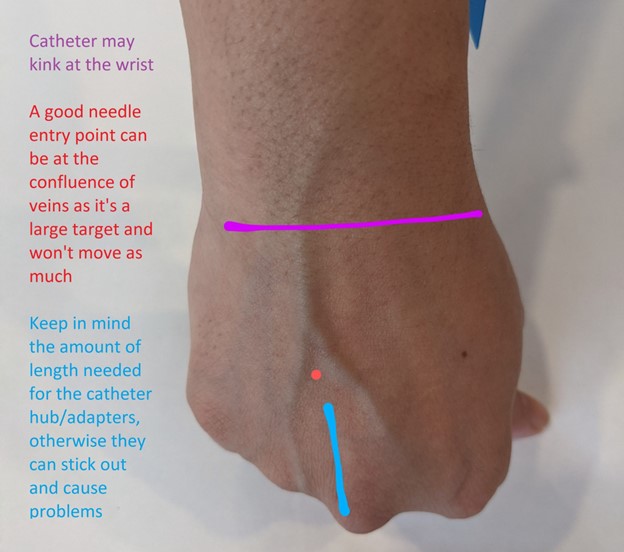A nurse is preparing to insert an IV catheter for an adult client.
Which of the following actions should the nurse take?
Choose the most proximal site on the extremity selected.
Apply a cool compress for several minutes before insertion of the IV catheter.
Place the tourniquet below the proposed insertion site.
Place the extremity in a dependent position.
The Correct Answer is D
The nurse should place the extremity in a dependent position before inserting an IV catheter.
This helps to dilate the veins and make them more visible and easier to access.

Choice A is wrong because the nurse should choose a site that is distal to the most proximal site on the extremity selected.
This helps to preserve more proximal sites for future use if needed.
Choice B is wrong because applying a cool compress before insertion of an IV catheter can cause vasoconstriction and make it more difficult to access the vein.
Instead, a warm compress can be applied to help dilate the veins.
Choice C is wrong because the tourniquet should be placed above, not below, the proposed insertion site to help dilate the vein and make it easier to access.
Nursing Test Bank
Naxlex Comprehensive Predictor Exams
Related Questions
Correct Answer is C
Explanation
This statement indicates that the client will be provided with information about advance directives before making a decision.
Advance directives are legal documents that allow individuals to communicate their wishes for medical treatment in the event that they are unable to make decisions for themselves.
Choice A is wrong because signing advance directives is not a requirement for undergoing surgery.
Choice B is wrong because the provider does not need to sign the advance directives.
Choice D is wrong because the presence of a partner is not required when signing advance directives.
Correct Answer is D
Explanation
Ask a second nurse to record her signature when wasting any unused portion of the controlled substance.
This is because if a controlled substance is wasted, this waste must be witnessed by and documented by the wasting nurse and another nurse.
Choice A is wrong because the count total of the controlled substance should be verified before removing the amount needed, not after.
Choice B is wrong because the wasted portion of the controlled substance should not be placed in the sharps container.
It should be disposed of according to facility/agency policy.
Choice C is wrong because any discrepancy in the count total of the controlled substance should be reported immediately, not after administration 1.
Whether you are a student looking to ace your exams or a practicing nurse seeking to enhance your expertise , our nursing education contents will empower you with the confidence and competence to make a difference in the lives of patients and become a respected leader in the healthcare field.
Visit Naxlex, invest in your future and unlock endless possibilities with our unparalleled nursing education contents today
Report Wrong Answer on the Current Question
Do you disagree with the answer? If yes, what is your expected answer? Explain.
Kindly be descriptive with the issue you are facing.
